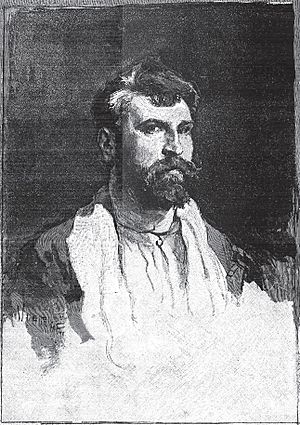Daniel Vierge facts for kids
Quick facts for kids
Daniel Vierge
|
|
|---|---|

Self-portrait (date unknown)
|
|
| Born |
Daniel Urrabieta y Vierge
5 March 1851 Madrid, Spain
|
| Died | 10 May 1904 (aged 53) Boulogne-sur-Seine, France
|
Daniel Urrabieta y Vierge (born March 5, 1851 – died May 10, 1904) was a talented Spanish-born French artist. He was an illustrator who changed how pictures were printed in books and newspapers. His work made illustrations look much better and more like real art.
Contents
Life of a Revolutionary Illustrator
Early Life and Moving to Paris
Daniel Vierge was born in Madrid, Spain. When he was 16, in 1867, he moved to Paris, France. He wanted to become a successful artist there.
In 1870, he started working for a newspaper called Le Monde illustré. This was just before the Franco-Prussian War began. At the newspaper, he learned a lot from Edmond Morin. Morin was a famous artist who believed newspaper drawings should be as good as fine art. Vierge's early drawings showed Morin's influence.
Developing His Unique Style
Vierge quickly showed his amazing artistic skill. Besides his own original drawings, he also had to redraw sketches from other artists. These sketches were sent in by reporters from places like Rome and Spain. His brother, Samuel Urrabieta, was one of these artists.
From 1871 to 1878, Vierge's own style became very clear. He created many well-known drawings during this time. Some of these included "Christmas in Spain" and "The Bull Fight."
Illustrating Famous Books
Vierge also illustrated many important books. He drew pictures for Victor Hugo's Année terrible and Les Misérables. His biggest illustration project was for Michelet's History of France. This huge work had 26 volumes and included 1,000 of Vierge's drawings.
Changing How Art Was Printed
In 1882, Vierge worked on an edition of Francisco de Quevedo's Historia de la vida del Buscón llamado don Pablos. This project was very important for printing. It greatly improved the technique of photoengraving.
Before this, artists and engravers had to trace drawings by hand. This often changed the original artwork. Photo-reproduction allowed Vierge's detailed drawings to be printed almost exactly as he drew them. This was a big step forward for art reproduction.
Later Works and Exhibitions
Vierge continued to illustrate books, like L'Espagnole in 1891. He also had exhibitions of his drawings in Paris. In 1898, he showed his work for Chateaubriand's Le Dernier Abencérage. The next year, he had a big exhibition of his work, including drawings for Don Quixote.
In 1898, Vierge contributed to L'Image, a magazine that promoted wood-engraving. In 1900, he won a major award at the International Exhibition in Paris.
Overcoming Challenges
Vierge was not a very fast artist. He faced a big challenge when he had a stroke at age 30. This made it hard for him to use his right hand. But he didn't give up! He learned to draw with his left hand instead. He passed away in Boulogne-sur-Seine at the age of 53.
See also
 In Spanish: Daniel Urrabieta Vierge para niños
In Spanish: Daniel Urrabieta Vierge para niños

